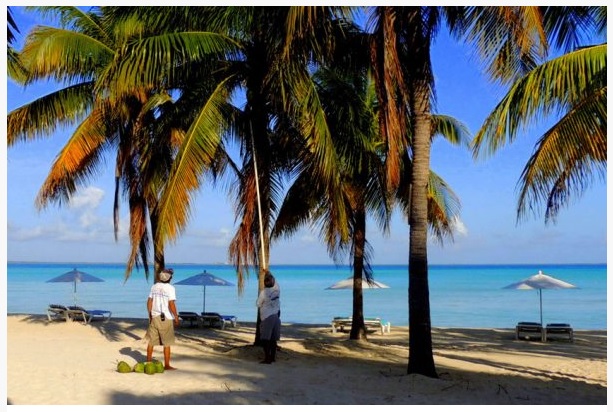The writers of this post are Lynda L. and Lawrie Lock, Canadians who have been full-time residents of Isla Mujeres for nearly 10 years. You can read their blog here….
At Isla Mujeres there are many unusual careers not available in any other country in the world, like picking coconuts.
Thunk! Nervous giggles follow the sound of a large ripe coconut slamming into the soft sand of Playa Norte.
Two workers are harvesting coconuts from the palm trees on the public beaches, clearing away the potential hazards before they tumble down on the heads of unsuspecting sun worshippers.
Instead of idealistically shinnying up the tree to pick the harvest, one of the men has a long-handled trimming device to free the fruit. He and his co-worker are keeping a wary eye on the hanging coconuts, rapidly moving aside when it looks as if a falling object is headed their way.
The twitter of uneasy laughter indicates another near miss.
Weighing about one and a half kilograms each, freshly harvested coconuts are then sold to the roadside vendors and restaurant owners for six pesos apiece, about 40 cents US.
Using a razor-sharp machete the vendors lop off the top and insert a straw. The coconut becomes a nourishing drink filled with magnesium, potassium, amino acids and vitamin B. Or they can be the base for an exotic fruit juice and alcohol concoction, decorated with a tiny paper umbrella and a tropical hibiscus flower.

Photo: http://lynda-notesfromparadise.blogspot.mx/
A little farther along on the same beach a group of fishermen is busy repairing nets, weaving new strands into the torn areas and clearing out the debris entangled in the filaments. The tang of salt, fish and seaweed floats on the air while the men share gossip, laughter and cervezas.
Nearby another fisherman is weaving a new net; his fingertips are covered with adhesive tape to limit friction injuries. In one hand he holds a wooden bobbin loaded with new nylon twine while his other hand lifts the threads.
His actions are a cross between weaving and sewing; rhythmic, smooth, and familiar. The result is an open grid pattern, but similar to the designs used by local hammock makers.
Closer to the northern end of Rueda Medina a vendor strides past, carefully balancing a tray of peanuts and snacks on his head.
“Cacahuates! Cacahuates!”
In the larger cities of the world, if you grin at strangers you are perceived as being a bit odd, someone to be avoided. On Isla Mujeres smiling works wonders. Islanders normally acknowledge the smile with a wide grin and a friendly greeting, “Hola, buenos días.”

Photo: http://lynda-notesfromparadise.blogspot.mx/
Meanwhile all around us on the streets mobile vendors ply their trade selling newspapers or popcorn, Oaxaca cheese or pastries, shoes or tamales, cold drinks or clay pots. Each vendor announces his or her products with accompanying songs, shouts, whistles, bicycle bells or horns. The sounds, the movement and the colours all add to the allure of living here.
Later in the summer the employees of the Tortugranja, the turtle farm, load newly hatched babies into heavy plastic tubs and truck them to the water’s edge. When released the hatchings frantically paddle across the sand toward the ocean.

Photo: http://lynda-notesfromparadise.blogspot.mx/
If we were still working, that would be our job of choice, a turtle release specialist. We would like to be the ones who start them on their arduous journey to the open ocean, and to greet the mamas when they return to lay their eggs on the beaches of Isla Mujeres.
That’s another unusual career not available in Canada.
The writers are Canadians who have been full-time residents of Isla Mujeres for nearly 10 years. You can read their blog here.


